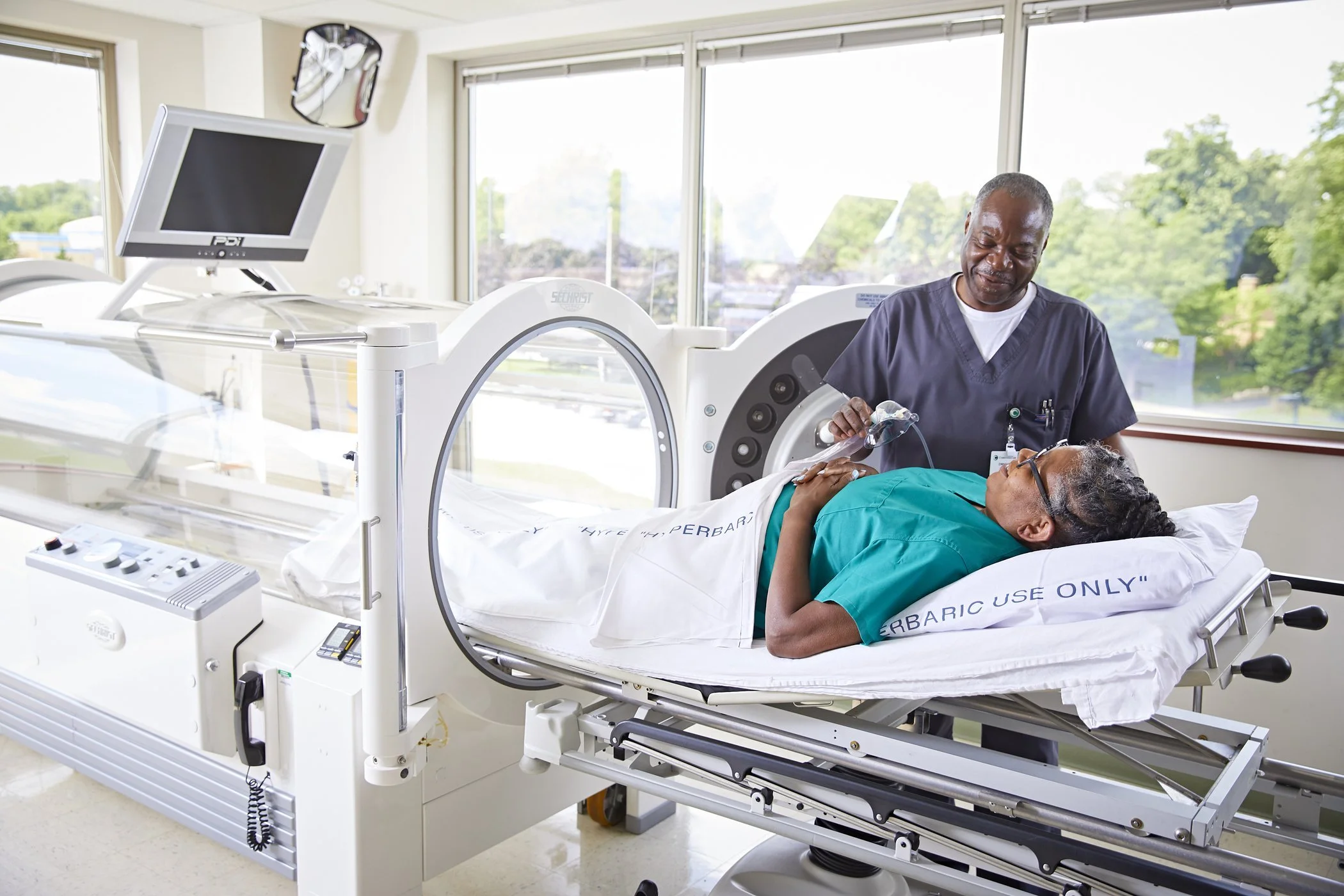What is Hyperbaric Oxygen Therapy?
According to the Undersea and Hyperbaric Medical Society (UHMS), hyperbaric oxygen therapy is the treatment of a disease or medical condition by the inhalation of near 100% (at least 95%) medical grade oxygen at pressures greater than 1 atmosphere absolute (ATA) in a pressure vessel constructed for that purpose. This is a noninvasive procedure.
How does HBOT work?
Normally we breathe about 21% oxygen at sea level. While we are under pressure and breathing 100% oxygen this allows the oxygen to be pushed into and dissolved directly in the blood plasma. By increasing the oxygen concentration in the body and pushing oxygen into plasma it can be carried into tissues much further and can help boost the body’s natural ability to heal. This mechanism of action is due to universal gas laws: Boyle’s Law, Henry’s law, and Dalton’s Law.
What are some benefits of HBOT?
Hyperoxygenation – helps with hypoxic cells and tissues by bringing oxygen back to them and creating an oxygen rich system.
Anti-inflammatory – helps create a balance between pro-inflammatory and anti-inflammatory chemicals. HBOT ameliorates inflammation throughout the body.
Antimicrobial effects – helps to kill the anaerobic pathogens and microbes on and in us while healing the aerobic microbes, while also helping create a balance of a healthy microbiome.
Neovascularization – assists in the healing and stimulation of development of blood vessels.
Stem Cell Mobilization - releases stem cells and about 8 times as much mobilization.
Mitochondrial Support – aids in cellular energy production and efficiency.
What can HBOT treat?
There are 13 FDA approved conditions:
Air and gas bubbles in the blood vessels
Anemia (severe anemia when blood transfusions cannot be used)
Burns (severe and large burns treated at a specialized burn center)
Carbon Monoxide poisoning
Crush Injury
Decompression Sickness
Gas Gangrene
Hearing loss (complete hearing loss that occurs suddenly without any known cause)
Infection of the skin and bone (severe)
Radiation Injury
Skin graft flap at risk of tissue death
Vision loss (when sudden and painless in one eye due to blockage of blood flow)
Wounds (non-healing, diabetic foot ulcers)
Many physicians and hyperbaric facilities are using and studying HBOT for off-label uses such as:
Alzheimer’s
Arthritis
Autism
Cancer
Cerebral Palsy
Chronic Pain
Concussion & Traumatic Brain injury
Crohn’s Disease
Fibromyalgia
Inflammatory Bowel Disease
Migraine/Headaches
Multiple Sclerosis
Parkinson’s
Spinal Cord Injuries
Stroke
Surgery Preparation & Recovery
Many of these are being studied in conjunction with current treatment regimen and use HBO as an additional therapy.
Types of HBOT Chambers:
Monoplace Chambers hold one person at a time and are pressurized by air or oxygen and the patient is given 100% oxygen to breathe through a mask or tube if the chamber is pressurized by air. These chambers typically only reach 3 ATA. Multiplace Chambers hold two people, and some can hold as many as 24 people at one time. They are pressurized with air and each patient is given a mask or oxygen hood to breathe 100% oxygen. In these chambers the hyperbaric technicians will accompany the patients inside and are able to give hands-on care. These chambers can reach 6 ATA.
How many HBOT treatments do I need?
Some patients will feel a difference in just one treatment. According to Paul G. Harch, MD author of The Oxygen Revolution, with a before and after SPECT scan of the brain blood flow you can see changes in the brain and depending on the percentage of change you will know, generally, how your patient will react to HBOT. Some patients need 8-10 treatments, and you could have patients that need upwards of 120+ treatments. It depends on several factors like condition, severity, length of time after an incident, how your patient responds to the treatment, etc. but a standard treatment regimen for HBOT is 40 consistent treatments.
What are the risks of HBOT?
HBOT is one of the safest medical procedures available. It has treatable and temporary side effects that happen in rare cases such as: pressure injury to the ears, temporary vision changes, low blood sugar, and fatigue. In extremely rare cases oxygen toxicity seizures and pressure injury to the lungs can occur.

